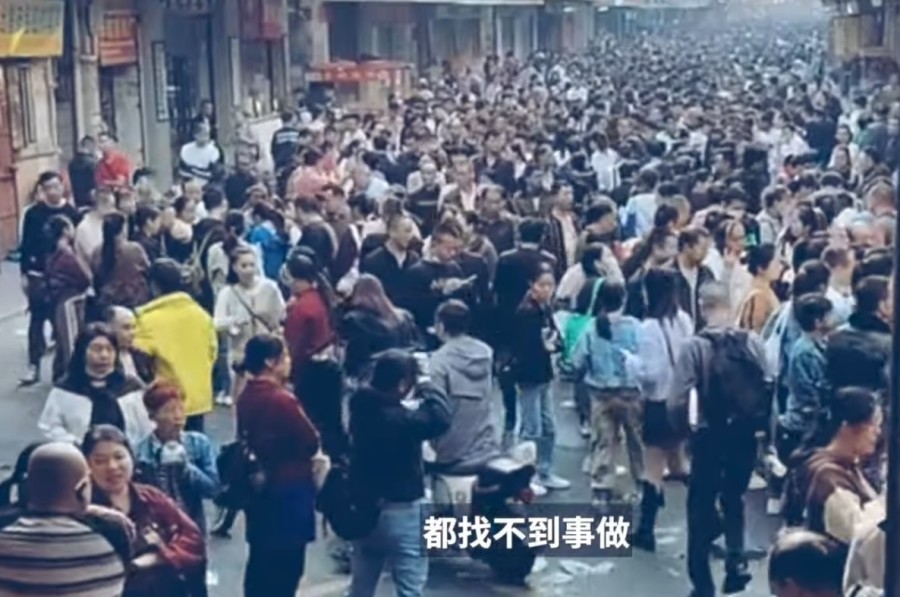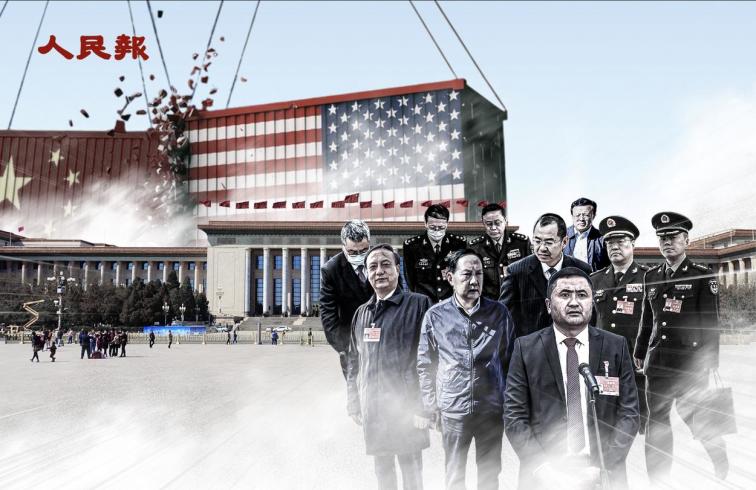This is a labour market in Guangzhou, where unemployment is rising. Many people are even pleading: "As long as there’s food to eat, it’s enough." (Screenshot from video)
[People News] A new term, “large-scale return to hometowns,” has recently become a hot topic. What is the background?
This winter, multiple provinces have seen early return-to-hometown trends, noticeably earlier than in previous years. Based on the data, this is not an “emotional” judgment but an evidence-based overflow of structural pressure.
Below, we let the data speak.
I. Signals of Early Return: The Employment Structure Is Already Cooling
1. Manufacturing PMI: Continuously at a Low Level
According to data from the National Bureau of Statistics:
· The manufacturing PMI has fallen into the contraction range (<50) multiple times since 2023.
· In 2024 and 2025, the manufacturing PMI for many months hovered around the “49 range.”
Manufacturing is the dominant industry absorbing migrant workers (about 45%).
Persistent weakness in PMI means: insufficient momentum for job expansion.
2. Enterprise Labor Demand: Official Data Declining
According to the Ministry of Human Resources and Social Security’s “National Job-Opening-to-Applicant Ratio in Q3 2024”:
· Job-opening-to-applicant ratio = 1.03
· It has declined for multiple consecutive quarters (it was 1.56 in Q1 2022)
A declining ratio indicates: the number of job positions per job seeker is shrinking.
3. Uneven Recovery in the Service Sector: Visitor Flow Data Is Clear
According to publicly available data from the Ministry of Transport and the Ministry of Culture and Tourism:
· Summer and Golden Week travel volume in 2024 clearly recovered
· But after October, service sector recovery slowed
· Many regions saw restaurants and retail enter an “early off-season”
The service sector absorbs over 50% of migrant workers.
Seasonal decline in services → combined with weakening manufacturing → strengthens labor outflow from cities.
II. Scale of the Return-to-Hometown Wave: Local Statistics Show Clear Signals
Although nationwide “early return” data will not be made public, observable clues already exist regionally.
Hengyang County, Hunan Province (local announcement)
· Estimated returnees: 183,000
· Over 40,000 “did not return to work”
The “return — no-return-to-work ratio” disclosed locally is very telling.
If similar patterns hold across major labor-exporting regions in central and western China, the pressure is significant.
III. Why Is It “Hard to Stay” After Returning Home? Data on Rural Absorption Capacity Make It Clearer
1. Rural Industries Have Limited Capacity to Absorb Employment
According to the National Bureau of Statistics and the Ministry of Agriculture and Rural Affairs:
· Primary industry share of national employment: 23% (and declining yearly)
· Local rural “non-agricultural industries” still account for less than 20% of employment
This means:
Rural industries themselves cannot absorb new labor.
2. Rural Income Structure: Wage Income Is the Most Important Source
According to the National Bureau of Statistics “2024 Rural Resident Income Composition”:
· Wage income share: 45.2%
· Net operational income: 35.5%
· The rest is transfer income
In other words, nearly half of rural family income comes from working in cities.
When urban income falls, rural areas cannot make up the gap.
3. Rural Per-Capita Disposable Income vs. Urban Income
· Urban residents: ~49,000 yuan/year
· Rural residents: ~21,000 yuan/year
The gap remains 2.3 times.
Returning home = significant income drop, a structural fact.
IV. The Rule Used to Be “Return After Spring Festival,” but the Rule Is Loosening
According to the National Bureau of Statistics migrant worker monitoring reports:
2015–2019: post-holiday return-to-work rate reached 96–98%
2021–2023: dropped year by year to 92–94%
Reasons for the decline include:
· Reduced manufacturing orders
· Noticeable downturn in construction cycles
· Increasing volatility in services
· More intense job competition among young workers
Declining return-to-work rates show that the group “not returning to work” after early return is expanding.
V. “Empirical Triangle” of Structural Pressure
After organizing the data, we see three clear logic chains:
1. Cities: Slower Job Growth
· Manufacturing PMI in contraction many months
· Job-opening ratio declining to 1.03
· Uneven service recovery
→ Pushes early return to hometowns
2. Rural Areas: Insufficient Industrial Capacity to Absorb Workers
· Wage income accounts for 45% of rural income
· Local non-agricultural industries below 20%
· Rural per-capita income less than half that of urban
→ “Returning home ≠ Employment”
3. National: Changes in Labor Force Age Structure
According to National Bureau of Statistics data:
· China’s 16–59 labor-age population share declining yearly
· Aging accelerating
· Labor demand shifting toward high-skill jobs
→ Low-skill jobs decreasing, high-skill jobs not fully replacing them
→ Labor force caught in a structural “middle-layer anxiety”
VI. The Real Crisis Is Not “Returning Home,” but “Returning to Poverty”
Early return = urban risk overflow
Difficulty returning to work = rural absorption weakness
Income decline = rising household pressure
Structural contradictions appear in three aspects:
Tight household cash flow
-
Decline in wage income → decline in primary cash source for rural families.
-
Dual pressure on both urban and rural areas
-
Cities are not expanding jobs, rural areas are not increasing income.
-
Greatest impact on people with medium education and low skills
They were once silent contributors and beneficiaries of China’s economic growth; job fluctuations now hurt them the most.
VII. In the Long Run, This Is a “Structural Turning Point”
Based on empirical data, we can observe:
-
Urban employment structure is transforming
Fewer low- and mid-end jobs; more high-skill jobs, but matching is insufficient. -
Rural industries still need catching up
Agricultural modernization and rural commercialization are still in early stages. -
The protection system needs linkage
Migrant populations lack an institutional “buffer zone” between cities and countryside.
VIII. Conclusion: The Return Wave Is a Mirror
It shows:
China’s economy is transitioning from high-speed growth to a phase of structural adjustment.
When urban jobs shrink, rural industries lag behind, and social protection remains unstable, early return becomes a real form of “voting with their feet.”
Thus, understanding the return wave helps us understand:
· New changes in urban–rural gaps
· New pressures in the employment structure
· The real pace of industrial upgrading
—This is precisely the key indicator most worthy of attention as China’s economy enters a new stage.
(Reprinted from “Cloud Canaan”) △











News magazine bootstrap themes!
I like this themes, fast loading and look profesional
Thank you Carlos!
You're welcome!
Please support me with give positive rating!
Yes Sure!